The Cloud Vision API lets you understand the content of an image by encapsulating powerful machine learning models in a simple REST API.
In this lab, we will send images to the Vision API and see it detect objects, faces, and landmarks.
What you'll learn
- Creating a Vision API request and calling the API with curl
- Using the label, web, face, and landmark detection methods of the vision API
What you'll need
How will you use this tutorial?
How would rate your experience with Google Cloud Platform?
Self-paced environment setup
If you don't already have a Google Account (Gmail or Google Apps), you must create one. Sign-in to Google Cloud Platform console (console.cloud.google.com) and create a new project:
Remember the project ID, a unique name across all Google Cloud projects (the name above has already been taken and will not work for you, sorry!). It will be referred to later in this codelab as PROJECT_ID.
Next, you'll need to enable billing in the Cloud Console in order to use Google Cloud resources.
Running through this codelab shouldn't cost you more than a few dollars, but it could be more if you decide to use more resources or if you leave them running (see "cleanup" section at the end of this document).
New users of Google Cloud Platform are eligible for a $300 free trial.
Click on the menu icon in the top left of the screen.

Select APIs & services from the drop down and click on Dashboard
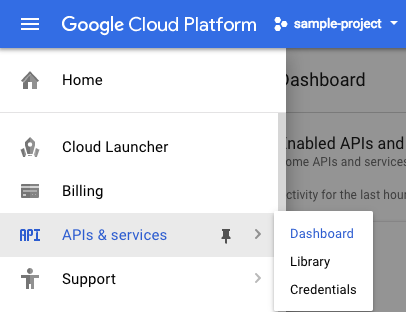
Click on Enable APIs and services.

Then, search for "vision" in the search box. Click on Google Cloud Vision API:
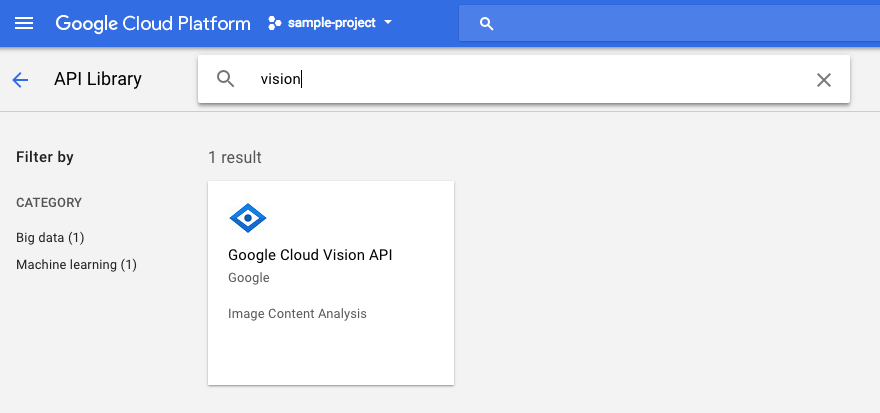
Click Enable to enable the Cloud Vision API:

Wait for a few seconds for it to enable. You will see this once it's enabled:

Google Cloud Shell is a command line environment running in the Cloud. This Debian-based virtual machine is loaded with all the development tools you'll need (gcloud, bq, git and others) and offers a persistent 5GB home directory. We'll use Cloud Shell to create our request to the Speech API.
To get started with Cloud Shell, Click on the "Activate Google Cloud Shell"  icon in top right hand corner of the header bar
icon in top right hand corner of the header bar

A Cloud Shell session opens inside a new frame at the bottom of the console and displays a command-line prompt. Wait until the user@project:~$ prompt appears
Since we'll be using curl to send a request to the Vision API, we'll need to generate an API key to pass in our request URL. To create an API key, navigate to the Credentials section of APIs & services in your Cloud console:


In the drop down menu, select API key:
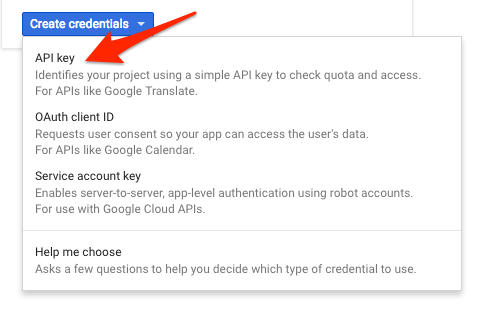
Next, copy the key you just generated.
Now that you have an API key, save it to an environment variable to avoid having to insert the value of your API key in each request. You can do this in Cloud Shell. Be sure to replace <your_api_key> with the key you just copied.
export API_KEY=<YOUR_API_KEY>Creating a Cloud Storage bucket
There are two ways to send an image to the Vision API for image detection: by sending the API a base64 encoded image string, or passing it the URL of a file stored in Google Cloud Storage. We'll be using a Cloud Storage URL. We'll create a Google Cloud Storage bucket to store our images.
Navigate to the Storage browser in the Cloud console for your project:
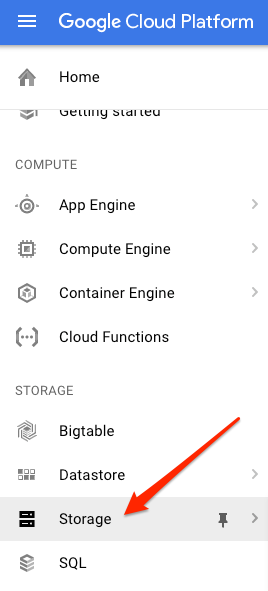
Then click Create bucket. Give your bucket a unique name (such as your Project ID) and click Create.
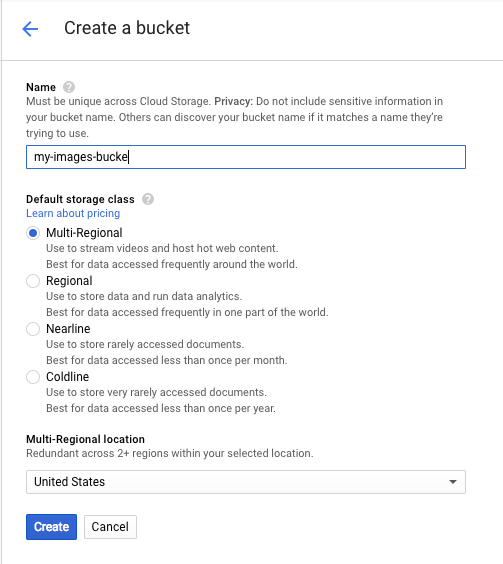
Upload an image to your bucket
Right click on the following image of donuts, then click Save image as and save it to your Downloads folder as donuts.png.

Navigate to the bucket you just created in the storage browser and click Upload files. Then select donuts.png.

You should see the file in your bucket:

Next, edit the permission of the image.

Click Add Item.
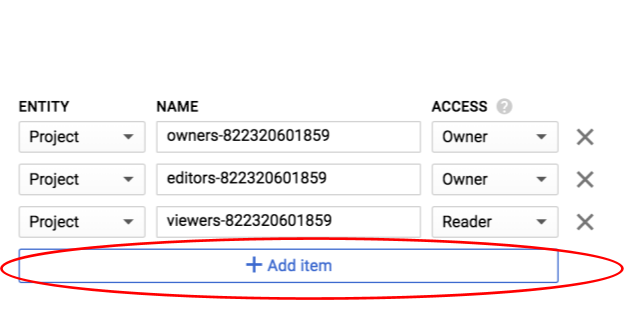
Add a new Entity of Group, and Name of allUsers:

Click Save.
Now that you have the file in your bucket, you're ready to create a Vision API request, passing it the URL of this donuts picture.
In your Cloud Shell environment, create a request.json file with the code below, making sure to replace my-bucket-name with the name of the Cloud Storage bucket you created. You can either create the file using one of your preferred command line editors (nano, vim, emacs) or use the built-in Orion editor in Cloud Shell:

request.json
{
"requests": [
{
"image": {
"source": {
"gcsImageUri": "gs://my-bucket-name/donuts.png"
}
},
"features": [
{
"type": "LABEL_DETECTION",
"maxResults": 10
}
]
}
]
}The first Cloud Vision API feature we'll explore is label detection. This method will return a list of labels (words) of what's in your image.
We're now ready to call the Vision API with curl:
curl -s -X POST -H "Content-Type: application/json" --data-binary @request.json https://vision.googleapis.com/v1/images:annotate?key=${API_KEY}Your response should look something like the following:
{
"responses": [
{
"labelAnnotations": [
{
"mid": "/m/01dk8s",
"description": "powdered sugar",
"score": 0.9436922
},
{
"mid": "/m/01wydv",
"description": "beignet",
"score": 0.7160288
},
{
"mid": "/m/06_dn",
"description": "snow",
"score": 0.71219236
},
{
"mid": "/m/02wvn_6",
"mid": "/m/0bp3f6m",
"description": "fried food",
"score": 0.7075312
},
{
"mid": "/m/02wvn_6",
"description": "ricciarelli",
"score": 0.5625
},
{
"mid": "/m/052lwg6",
"description": "baked goods",
"score": 0.53270763
}
]
}
]
}The API was able to identify the specific type of donuts these are (beignets), cool! For each label the Vision API found, it returns a description with the name of the item. It also returns a score, a number from 0 - 100 indicating how confident it is that the description matches what's in the image. The mid value maps to the item's mid in Google's Knowledge Graph. You can use the mid when calling the Knowledge Graph API to get more information on the item.
In addition to getting labels on what's in our image, the Vision API can also search the Internet for additional details on our image. Through the API's webDetection method, we get a lot of interesting data back:
- A list of entities found in our image, based on content from pages with similar images
- URLs of exact and partial matching images found across the web, along with the URLs of those pages
- URLs of similar images, like doing a reverse image search
To try out web detection, we'll use the same image of beignets from above so all we need to change is one line in our request.json file (you can also venture out into the unknown and use an entirely different image). Under the features list, just change type from LABEL_DETECTION to WEB_DETECTION. request.json should now look like this:
request.json
{
"requests": [
{
"image": {
"source": {
"gcsImageUri": "gs://my-bucket-name/donuts.png"
}
},
"features": [
{
"type": "WEB_DETECTION",
"maxResults": 10
}
]
}
]
}To send it to the Vision API, you can use the same curl command as before (just press the up arrow in Cloud Shell):
curl -s -X POST -H "Content-Type: application/json" --data-binary @request.json https://vision.googleapis.com/v1/images:annotate?key=${API_KEY}Let's dive into the response, starting with webEntities. Here are some of the entities this image returned:
"webEntities": [
{
"entityId": "/m/01hyh_",
"score": 0.7155,
"description": "Machine learning"
},
{
"entityId": "/m/01wydv",
"score": 0.48758492,
"description": "Beignet"
},
{
"entityId": "/m/0105pbj4",
"score": 0.3976,
"description": "Google Cloud Platform"
},
{
"entityId": "/m/02y_9m3",
"score": 0.3782,
"description": "Cloud computing"
},
...
]
This image has been reused in many presentations on our Cloud ML APIs, which is why the API found the entities "Machine learning," "Google Cloud Platform," and "Cloud computing".
If we inpsect the URLs under fullMatchingImages, partialMatchingImages, and pagesWithMatchingImages, we'll notice that many of the URLs point to this codelab site (super meta!).
Let's say we want to find other images of beignets, but not the exact same images. That's where the visuallySimilarImages part of the API response comes in handy. Here are a few of the visually similar images it found:
"visuallySimilarImages": [
{
"url": "https://igx.4sqi.net/img/general/558x200/21646809_fe8K-bZGnLLqWQeWruymGEhDGfyl-6HSouI2BFPGh8o.jpg"
},
{
"url": "https://spoilednyc.com//2016/02/16/beignetszzzzzz-852.jpg"
},
{
"url": "https://img-global.cpcdn.com/001_recipes/a66a9a6fc2696648/1200x630cq70/photo.jpg"
},
...
]We can navigate to those URLs to see the similar images:
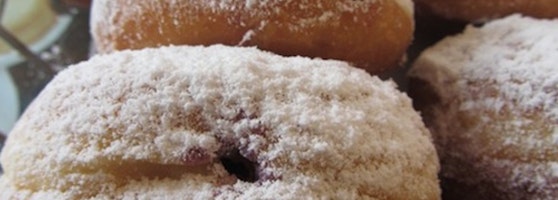
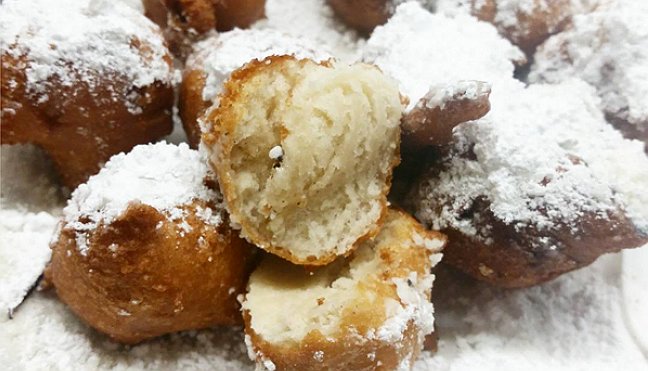


Cool! And now you probably really want a beignet (sorry). This is similar to searching by an image on Google Images:

But with Cloud Vision, we can access this functionality with an easy to use REST API and integrate it into our applications.
Next we'll explore the face and landmark detection methods of the Vision API. The face detection method returns data on faces found in an image, including the emotions of the faces and their location in the image. Landmark detection can identify common (and obscure) landmarks - it returns the name of the landmark, its latitude longitude coordinates, and the location of where the landmark was identified in an image.
Upload a new image
To use these two new methods, let's upload a new image with faces and landmarks to our Cloud Storage bucket. Right click on the following image, then click Save image as and save it to your Downloads folder as selfie.png.

Then upload it to your Cloud Storage bucket the same way you did in the previous step, making sure to check the "Share publicly" checkbox.
Updating our request
Next, we'll update our request.json file to include the URL of the new image, and to use face and landmark detection instead of label detection. Be sure to replace my-bucket-name with the name of our Cloud Storage bucket:
request.json
{
"requests": [
{
"image": {
"source": {
"gcsImageUri": "gs://my-bucket-name/selfie.png"
}
},
"features": [
{
"type": "FACE_DETECTION"
},
{
"type": "LANDMARK_DETECTION"
}
]
}
]
}Calling the Vision API and parsing the response
Now you're ready to call the Vision API using the same curl command you used above:
curl -s -X POST -H "Content-Type: application/json" --data-binary @request.json https://vision.googleapis.com/v1/images:annotate?key=${API_KEY}Let's take a look at the faceAnnotations object in our response first. You'll notice the API returns an object for each face found in the image - in this case, three. Here's a clipped version of our response:
{
"faceAnnotations": [
{
"boundingPoly": {
"vertices": [
{
"x": 669,
"y": 324
},
...
]
},
"fdBoundingPoly": {
...
},
"landmarks": [
{
"type": "LEFT_EYE",
"position": {
"x": 692.05646,
"y": 372.95868,
"z": -0.00025268539
}
},
...
],
"rollAngle": 0.21619819,
"panAngle": -23.027969,
"tiltAngle": -1.5531756,
"detectionConfidence": 0.72354823,
"landmarkingConfidence": 0.20047489,
"joyLikelihood": "POSSIBLE",
"sorrowLikelihood": "VERY_UNLIKELY",
"angerLikelihood": "VERY_UNLIKELY",
"surpriseLikelihood": "VERY_UNLIKELY",
"underExposedLikelihood": "VERY_UNLIKELY",
"blurredLikelihood": "VERY_UNLIKELY",
"headwearLikelihood": "VERY_LIKELY"
}
...
}
}The boundingPoly gives us the x,y coordinates around the face in the image. fdBoundingPoly is a smaller box than boundingPoly, encodling on the skin part of the face. landmarks is an array of objects for each facial feature (some you may not have even known about!). This tells us the type of landmark, along with the 3D position of that feature (x,y,z coordinates) where the z coordinate is the depth. The remaining values gives us more details on the face, including the likelihood of joy, sorrow, anger, and surprise. The object above is for the person furthest back in the image - you can see he's making kind of a silly face which explains the joyLikelihood of POSSIBLE.
Next let's look at the landmarkAnnotations part of our response:
"landmarkAnnotations": [
{
"mid": "/m/0c7zy",
"description": "Petra",
"score": 0.5403372,
"boundingPoly": {
"vertices": [
{
"x": 153,
"y": 64
},
...
]
},
"locations": [
{
"latLng": {
"latitude": 30.323975,
"longitude": 35.449361
}
}
]Here, the Vision API was able to tell that this picture was taken in Petra - this is pretty impressive given the visual clues in this image are minimal. The values in this response should look similar to the labelAnnotations response above.
We get the mid of the landmark, it's name (description), along with a confidence score. boundingPoly shows the region in the image where the landmark was identified. The locations key tells us the latitude longitude coordinates of this landmark.
We've looked at the Vision API's label, face, and landmark detection methods, but there are three others we haven't explored. Dive into the docs to learn about the other three:
- Logo detection: identify common logos and their location in an image.
- Safe search detection: determine whether or not an image contains explicit content. This is useful for any application with user-generated content. You can filter images based on four factors: adult, medical, violent, and spoof content.
- Text detection: run OCR to extract text from images. This method can even identify the language of text present in an image.
You've learned how to analyze images with the Vision API. In this example you passed the API the Google Cloud Storage URL of your image. Alternatively, you can pass a base64 encoded string of your image.
What we've covered
- Calling the Vision API with curl by passing it the URL of an image in a Cloud Storage bucket
- Using the Vision API's label, web, face, and landmark detection methods
Next Steps
- Check out the Vision API tutorials in the documentation
- Find a Vision API sample in your favorite language
- Try out the Speech API and Natural Language API codelabs!
